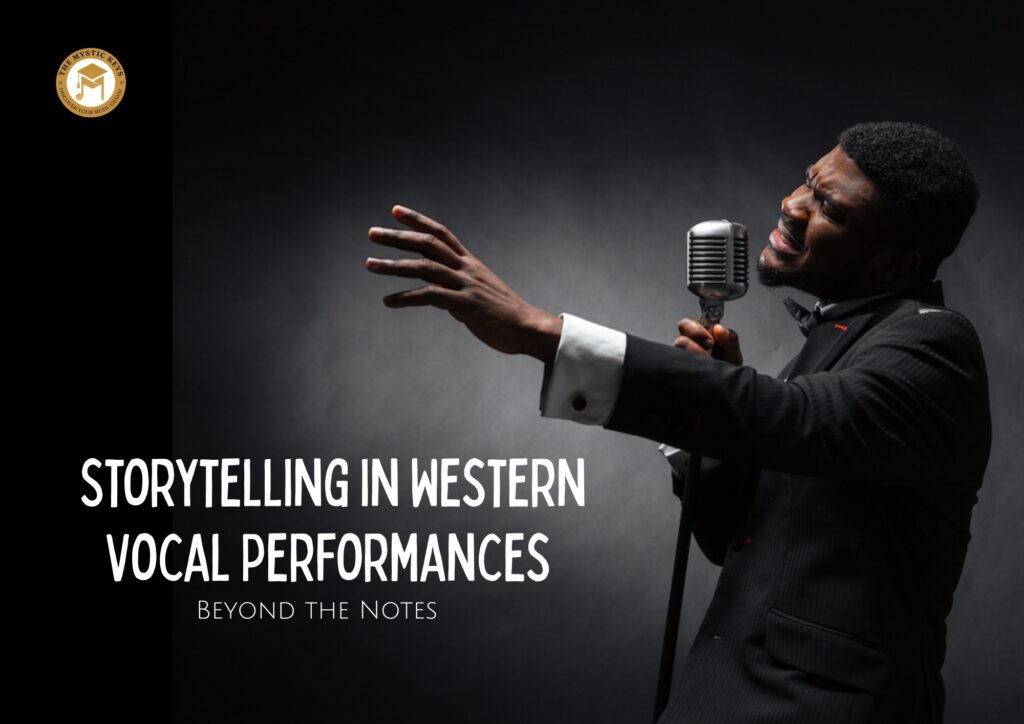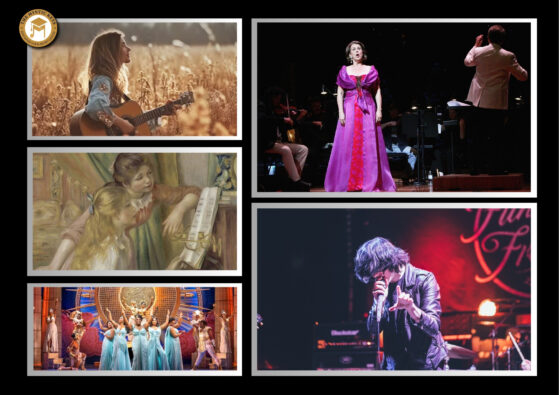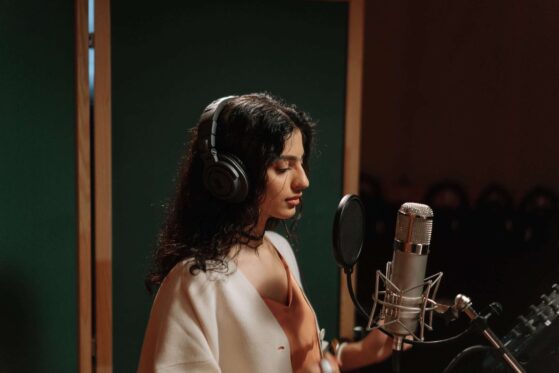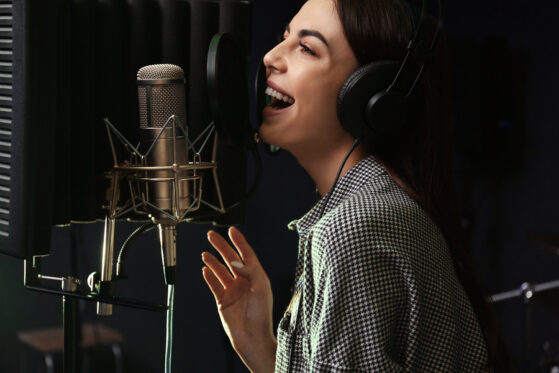
Storytelling in Western Vocal Performances | Beyond the Notes
Storytelling in Western Vocal Performances | Beyond the Notes
When we think of Western vocal performances, what often comes to mind is stunning vocal technique, emotional delivery, and powerful stage presence. But at the heart of every truly memorable performance lies a deeper element—storytelling in Western vocal performances. Whether it’s a sweeping operatic aria, a heartfelt jazz ballad, or a Broadway showstopper, Western vocal music often transcends melody and rhythm to become a medium for narrative expression. It’s through storytelling that singers connect with their audience on a personal and emotional level, transforming a musical piece into a compelling human experience.
In this blog, we’ll take a closer look at the vital role of storytelling in Western vocal performances. We’ll explore how singers seamlessly weave together words, music, and emotion—not just to sing, but to tell compelling stories. Through this blend, they move beyond mere performance to truly bring narratives to life, drawing listeners in, stirring deep emotions, and ultimately creating a lasting connection. Whether performing on grand opera stages or in intimate concert settings, these vocalists use storytelling as a powerful tool to captivate audiences and bridge cultural and generational divides.

The Essence of Vocal Storytelling
Unlike instrumental music, vocal performance has the unique advantage of language. Lyrics—whether in English, Italian, German, or French—allow singers to communicate explicit ideas and emotions. But storytelling in music is not just about singing the words. It involves interpreting them, embodying the character, and delivering a performance that paints a vivid picture for the listener.
In Western traditions, storytelling is central to genres such as:
Opera – where music and drama are inseparable
Art Song (Lieder) – where poets’ verses are interpreted musically
Musical Theatre – where every song advances the plot or character development
Folk and Country music – rich in personal and cultural narratives
Pop ballads – that reflect personal experiences and universal emotions
Every note, phrase, and gesture becomes a tool to build a story arc—with a beginning, conflict, climax, and resolution.

Historical Roots of Storytelling in Western Music
Western vocal storytelling has deep roots that trace back centuries. In medieval Europe, troubadours and minstrels would travel from town to town, singing ballads that told tales of love, war, betrayal, and heroism. These early narrative songs were vital in preserving and sharing oral history.
During the Baroque and Classical eras, composers like Handel and Mozart further elevated vocal storytelling through opera, using arias and recitatives to reflect the inner thoughts and dramatic conflicts of their characters.
By the 19th century, Romantic composers such as Schubert, Schumann, and Brahms focused intensely on Lieder—German art songs that wove poetic storytelling into intimate musical settings. These songs demanded not only technical skill but also interpretive depth, requiring the vocalist to become both singer and storyteller.

Characterization and Emotional Truth
A singer’s job is not just to hit the notes, but to embody a character. In Western vocal training—especially in musical theatre and opera—students are often taught to approach a song like an actor approaches a monologue.
Key questions a performer must ask include:
Who am I in this song?
What do I want?
What is standing in my way?
How do I feel about what’s happening?
These questions help create emotional truth in the performance. For example, when performing “I Dreamed a Dream” from Les Misérables, the vocalist isn’t merely showcasing their vocal range—they are conveying Fantine’s despair, broken dreams, and longing, transporting the audience into her world.
In jazz and pop, even without a character to portray, singers often tap into personal emotions and experiences to give the song depth. The art of phrasing, dynamics, and even silences between words becomes a form of dramatic storytelling.

The Power of Interpretation
Two singers can perform the same piece, and yet tell entirely different stories. That’s the beauty of storytelling in Western vocal performances—it thrives on interpretation. Choices in tempo, tone color, phrasing, and emphasis can completely transform the mood and meaning of a song. Through these interpretive decisions, singers breathe life into the music, revealing new emotional layers and perspectives with every rendition.
Take Schubert’s famous Erlkönig, for instance. The singer must portray four characters—the narrator, the father, the child, and the supernatural Erlking—all within one song. Through subtle shifts in vocal quality, register, and emotion, a single performer becomes a cast of characters, creating a mini-drama that lives entirely in the listener’s imagination.
In contemporary pop, a song like Adele’s “Someone Like You” relies on raw emotional delivery to tell a universally relatable story of lost love. What resonates with listeners is not just the melody, but the authenticity of her storytelling.

Storytelling Techniques in Performance
To effectively tell a story through song, Western vocalists often employ a range of techniques:
Text Analysis: Understanding the literal and emotional meaning of the lyrics.
Vocal Coloring: Adjusting the tone to reflect different moods (warmth, anger, sadness, joy).
Facial Expression and Body Language: Physical storytelling reinforces the emotions behind the words.
Dynamic Control: Using volume and intensity to highlight dramatic moments.
Timing and Phrasing: Manipulating rhythm to emphasize important words or emotions.
These techniques, when used with intention, create an immersive experience for the audience—one that feels personal, even in a crowded concert hall.

Connecting with the Audience
At its core, storytelling in Western vocal performance is about connection. It bridges the gap between singer and listener, turning a musical experience into something emotionally profound.
Audiences don’t always remember every technical detail of a performance. But they do remember how it made them feel. A powerful story, told with sincerity and skill, lingers long after the last note fades.
This is especially important in today’s digital age, where music is often consumed through recordings and videos. Even in these formats, a strong storyteller can reach into the listener’s heart, making them laugh, cry, or reflect—sometimes all in the same song.

Training the Storyteller’s Voice
Modern Western vocal education now puts greater focus on storytelling. It’s not just about vocal skills, but also emotional connection. To build this, students are encouraged to:
Study acting alongside singing
Learn the context of the songs they perform
Explore a wide repertoire to understand different narrative styles
Perform regularly to gain confidence and emotional range
Workshops, masterclasses, and coaching sessions often focus on dramatic interpretation, emotional authenticity, and stagecraft—all of which enhance the singer’s storytelling ability.

Conclusion: More Than Just Music
Western vocal performance is not merely about producing a beautiful sound—it’s about weaving meaning into melody, expressing emotion with authenticity, and bringing stories to life through song. Whether performed in the grandeur of an opera house or captured in the intimacy of a recording studio, storytelling remains at the heart of every powerful performance.
That’s why, for both aspiring singers and experienced performers, learning to understand and master the art of storytelling is essential. When vocal technique is combined with emotional depth and narrative purpose, a song becomes more than just music—it becomes an experience.
At The Mystic Keys, our Western Vocal Lessons Online are designed to help you unlock this very potential. We go beyond scales and vocal exercises, guiding you to discover the storyteller within. Whether you’re preparing for the stage or singing from your home studio, we help you bring each lyric to life with confidence and emotion.
Because in the end, it’s not just the notes that move us—it’s the story behind them.
Join The Mystic Keys today, and let your voice tell the story it was meant to.
For more information and exciting resources about learning music, visit our website at The Mystic Keys. For more music content and exciting offers follow us on
Facebook, Instagram, YouTube, LinkedIn, Twitter, Pinterest, and Threads,

